2026届高考英语二轮复习:句子结构课件(共20张PPT)
文档属性
| 名称 | 2026届高考英语二轮复习:句子结构课件(共20张PPT) | 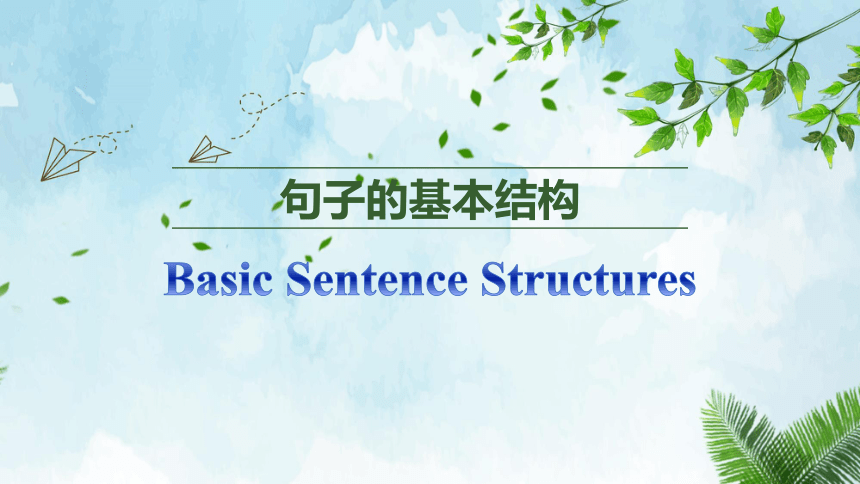 | |
| 格式 | pptx | ||
| 文件大小 | 1.1MB | ||
| 资源类型 | 教案 | ||
| 版本资源 | 通用版 | ||
| 科目 | 英语 | ||
| 更新时间 | 2025-06-24 12:27:11 | ||
图片预览

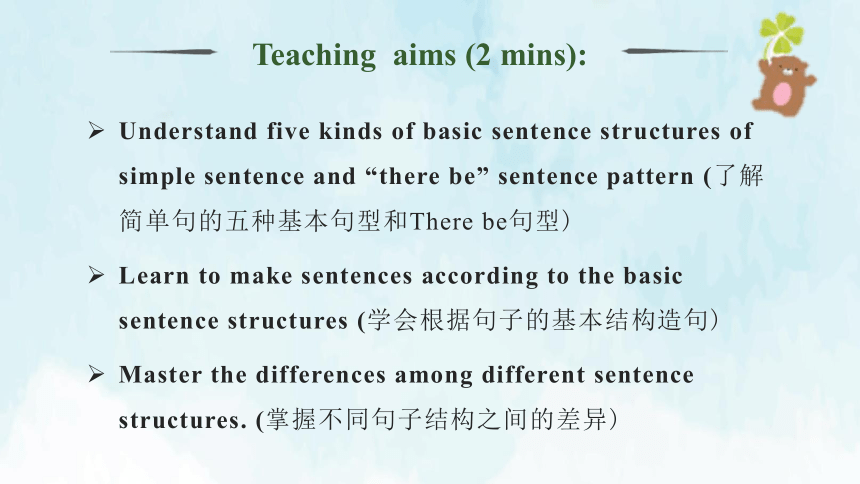
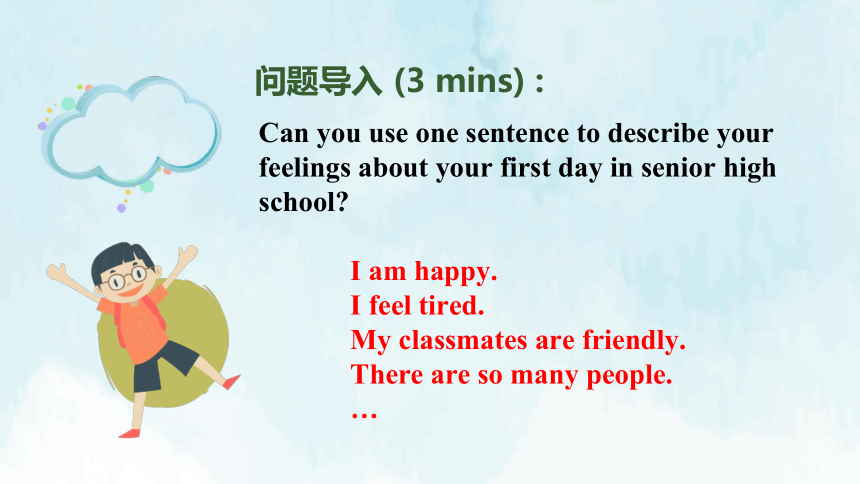
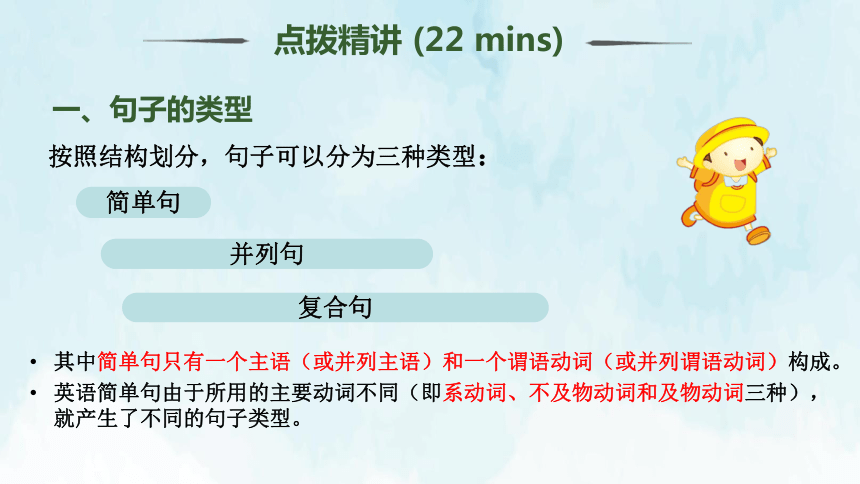

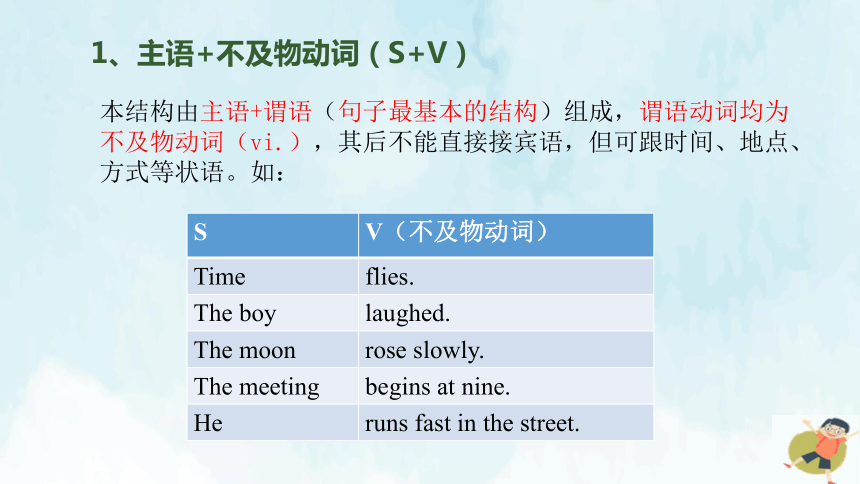
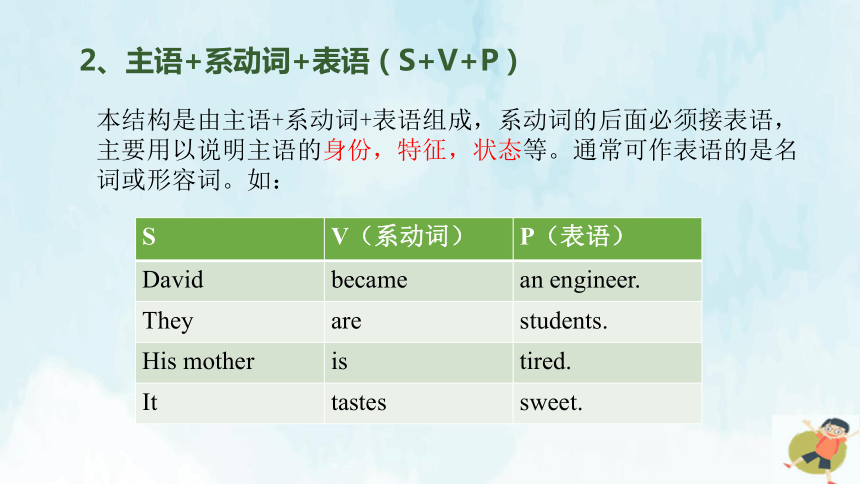

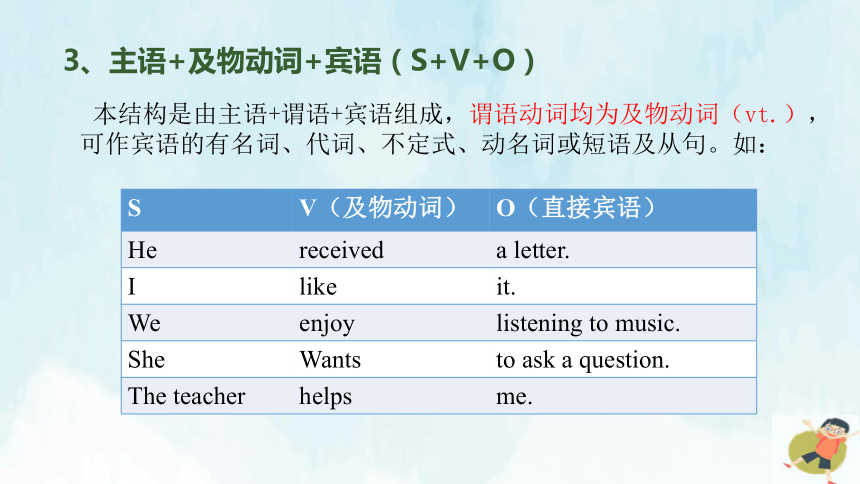
文档简介
(共20张PPT)
句子的基本结构
Basic Sentence Structures
Understand five kinds of basic sentence structures of simple sentence and “there be” sentence pattern (了解简单句的五种基本句型和There be句型)
Learn to make sentences according to the basic sentence structures (学会根据句子的基本结构造句)
Master the differences among different sentence structures. (掌握不同句子结构之间的差异)
Teaching aims (2 mins):
问题导入 (3 mins) :
Can you use one sentence to describe your feelings about your first day in senior high school
I am happy.
I feel tired.
My classmates are friendly.
There are so many people.
…
一、句子的类型
按照结构划分,句子可以分为三种类型:
简单句
并列句
复合句
其中简单句只有一个主语(或并列主语)和一个谓语动词(或并列谓语动词)构成。
英语简单句由于所用的主要动词不同(即系动词、不及物动词和及物动词三种),就产生了不同的句子类型。
点拨精讲 (22 mins)
二、简单句的五种基本句型
1
主语+不及物动词(S+V)
2
主语+系动词+表语(S+V+P)
3
主语+及物动词+宾语(S+V+O)
4
主语+及物动词+间接宾语+直接宾语(S+V+IO+DO)
5
主语+及物动词+宾语+宾语补足语(S+V+O+C)
1、主语+不及物动词(S+V)
本结构由主语+谓语(句子最基本的结构)组成,谓语动词均为不及物动词(vi.),其后不能直接接宾语,但可跟时间、地点、方式等状语。如:
S V(不及物动词)
Time flies.
The boy laughed.
The moon rose slowly.
The meeting begins at nine.
He runs fast in the street.
2、主语+系动词+表语(S+V+P)
本结构是由主语+系动词+表语组成,系动词的后面必须接表语,主要用以说明主语的身份,特征,状态等。通常可作表语的是名词或形容词。如:
S V(系动词) P(表语)
David became an engineer.
They are students.
His mother is tired.
It tastes sweet.
2、主语+系动词+表语(S+V+P)
类别 例子
表示特征和存在状态的 be, seem, feel, appear, look, smell, taste, sound;
表示状态延续的 remain, stay, keep, continue, stand;
表示状态变化的 become, get, turn, go, run, fall, come, grow;
系动词的类型:
3、主语+及物动词+宾语(S+V+O)
本结构是由主语+谓语+宾语组成,谓语动词均为及物动词(vt.),可作宾语的有名词、代词、不定式、动名词或短语及从句。如:
S V(及物动词) O(直接宾语)
He received a letter.
I like it.
We enjoy listening to music.
She Wants to ask a question.
The teacher helps me.
4、主语+及物动词+间接宾语+直接宾语(S+V+IO+DO)
宾语分直接宾语和间接宾语。直接宾语是及物动词的直接对象,但某些动词,除直接宾语外,还要求有一个间接宾语,表示动作是对谁做的,或是为谁做的(通常由名词或代词的宾格担任)。
可以接双宾语的及物动词有ask,give,tell,teach, buy, pass, lend, show, bring, send等,如:
S V IO DO
Emma taught the children English.
I sent her an email.
Mom bought me a new bag.
She told him a story.
4、主语+及物动词+间接宾语+直接宾语(S+V+IO+DO)
通常情况下,间接宾语位于直接宾语的前面,但有时根据强调需要,间接宾语位于直接宾语之后,这时要在间接宾语前加to或for。
如:
1. I will bring the book (直宾) to you (间宾) next time.
= I will bring you the book next time.
2. Mother bought a new bag (直宾) for him. (间宾)
= Mother bought him a new bag.
3. She sang several songs (直宾) for them. (间宾)
= She sang them several songs.
4. Please pass (谓) the salt (直宾)to me. (间宾)
= Please pass me the salt.
5、主语+及物动词+宾语+宾语补语(S+V+O+C)
宾语(O)与宾语补足语(C)之间有逻辑上的主谓关系或主表关系,若无宾语补足语,则句意不够完整。宾语补足语可以由名词,形容词,副词,介词短语,动词不定式,分词等来担任。
可带这种复合宾语的及物动词make, find, name, think, see,hear, call,leave等,如:
S V O C
I heard him singing
We call this kind of machines computers
The teacher made the student monitor
She found the boy very funny.
三、There be 句型
1. 定义:There be句型表示某处存在某物或某人。
2. 结构:(1) There is +单数可数名词/不可数名词+ 地点状语.
(2) There are +复数名词+地点状语.
※:谓语动词be要与主语(某人或某物)的数保持一致。当主语是两个或两个以上的名词时,谓语动词要与跟它最近的那个名词一致。(就近原则)
(1) There is a teacher and many students in our classroom.
(2) There are two boys and a girl under the tree.
三、There be 句型
※:There be句型的否定式在be后加上not或no即可。
注意::
1)not是副词,no为形容词,not a/an/any + n. 相当于no+ n.
There are some pictures on the wall.
否定 →There aren't any pictures on the wall.
=There are no pictures on the wall.
There is a bike behind the tree.
→ There isn't a bike behind the tree. =There is no bike behind the tree.
注意:
2)there be结构在改为否定或疑问句时,一般将some改为any。
There are some fish in the water. →There aren’t any fish in the water. /
Are there any fish in the water
结构 英文缩写 常见动词 备注
主语+谓语 S+V 谓语动词均为不及物动词,后面不跟宾语,但可跟时间、地点、方式等状语。
主语+谓语+宾语 S+V+DO 这里的谓语动词为及物动词,后面必须跟宾语。
主语+系动词+表语 S+V+P be, keep, seem, look, feel, smell, sound, taste, become, grow, turn, fall, get 这里的动词都为连系动词。
主语+谓语+间接宾语+直接宾语 S+V+IO+DO give, bring, show, pass, buy, make, tell, ask, get, teach, write, sing, lend, hand, sell, cost, pay 通常情况下,间接宾语位于直接宾语的前面,但有时根据需要,间接宾语位于直接宾语之后,这时要在间接宾语前加to或for
主语+谓语+宾语 +宾语补足语 S+V+DO+OC think, keep, make, name, call, see, hear, watch, help, let, tell, ask, paint, leave 宾语补足语部分可以为形容词,名词,不定式等形式
There be 句型 / / There be句型表示某处存在某物或某人。就近原则。
课堂小结(2mins)
一、请判断下列句子类型:
1. You must talk softly during the watch.
2. He told us not to make any noise.
3. Is there a baby in the room
4. You can watch the birds closely.
5. The zookeeper greeted us politely.
6. David teaches us English.
7. They shouted excitedly.
8. The child is dishonest.
9. The nature reserve gives wildlife an ideal home.
当堂训练(10mins)
(S+V)
(S+V+DO+OC)
(There be 句型)
(S+V+DO)
(S+V+DO)
(S+V+IO+DO)
(S+V)
(S+V+P)
(S+V+IO+DO)
1. Susan and I hard. (work)
选做题
【答案】work
【解析】本句考的是简单句中的主谓结构句型,即S+V结构,主语是Susan and I,根据主谓一致的原则,谓语动词应该用复数形式。
二、用所词的正确形式的填空。
2. He often his clothes on Sundays. ( wash )
【答案】washes
【解析】本句是“S+V+O”结构,要选择的是谓语。主语是第三人称单数,时间状语是often,所以要选一般现在时态。
3. We’ll make our school more . beauty
【答案】beautiful
本句是“S+V+O+C ”结构,形容词作宾语补足语。make + sth.+adj. , 该句中形容词和前面的more一起构成比较级。
选做题
4. There ______ a pen and two pencils on the desk. ( be )
【答案】is
考查There be 句型的就近原则。当主语是两个或两个以上的名词时,谓语动词要与跟它最近的那个名词一致。
Homework(1min)
Please write an article (about 100 words) by using different kinds of sentence structures you learned today to describe your first day in senior high school.
(请运用今天所学的不同句子结构写一篇大概100词的文章描述你上高中的第一天。)
Thank you!
2021/8/27
句子的基本结构
Basic Sentence Structures
Understand five kinds of basic sentence structures of simple sentence and “there be” sentence pattern (了解简单句的五种基本句型和There be句型)
Learn to make sentences according to the basic sentence structures (学会根据句子的基本结构造句)
Master the differences among different sentence structures. (掌握不同句子结构之间的差异)
Teaching aims (2 mins):
问题导入 (3 mins) :
Can you use one sentence to describe your feelings about your first day in senior high school
I am happy.
I feel tired.
My classmates are friendly.
There are so many people.
…
一、句子的类型
按照结构划分,句子可以分为三种类型:
简单句
并列句
复合句
其中简单句只有一个主语(或并列主语)和一个谓语动词(或并列谓语动词)构成。
英语简单句由于所用的主要动词不同(即系动词、不及物动词和及物动词三种),就产生了不同的句子类型。
点拨精讲 (22 mins)
二、简单句的五种基本句型
1
主语+不及物动词(S+V)
2
主语+系动词+表语(S+V+P)
3
主语+及物动词+宾语(S+V+O)
4
主语+及物动词+间接宾语+直接宾语(S+V+IO+DO)
5
主语+及物动词+宾语+宾语补足语(S+V+O+C)
1、主语+不及物动词(S+V)
本结构由主语+谓语(句子最基本的结构)组成,谓语动词均为不及物动词(vi.),其后不能直接接宾语,但可跟时间、地点、方式等状语。如:
S V(不及物动词)
Time flies.
The boy laughed.
The moon rose slowly.
The meeting begins at nine.
He runs fast in the street.
2、主语+系动词+表语(S+V+P)
本结构是由主语+系动词+表语组成,系动词的后面必须接表语,主要用以说明主语的身份,特征,状态等。通常可作表语的是名词或形容词。如:
S V(系动词) P(表语)
David became an engineer.
They are students.
His mother is tired.
It tastes sweet.
2、主语+系动词+表语(S+V+P)
类别 例子
表示特征和存在状态的 be, seem, feel, appear, look, smell, taste, sound;
表示状态延续的 remain, stay, keep, continue, stand;
表示状态变化的 become, get, turn, go, run, fall, come, grow;
系动词的类型:
3、主语+及物动词+宾语(S+V+O)
本结构是由主语+谓语+宾语组成,谓语动词均为及物动词(vt.),可作宾语的有名词、代词、不定式、动名词或短语及从句。如:
S V(及物动词) O(直接宾语)
He received a letter.
I like it.
We enjoy listening to music.
She Wants to ask a question.
The teacher helps me.
4、主语+及物动词+间接宾语+直接宾语(S+V+IO+DO)
宾语分直接宾语和间接宾语。直接宾语是及物动词的直接对象,但某些动词,除直接宾语外,还要求有一个间接宾语,表示动作是对谁做的,或是为谁做的(通常由名词或代词的宾格担任)。
可以接双宾语的及物动词有ask,give,tell,teach, buy, pass, lend, show, bring, send等,如:
S V IO DO
Emma taught the children English.
I sent her an email.
Mom bought me a new bag.
She told him a story.
4、主语+及物动词+间接宾语+直接宾语(S+V+IO+DO)
通常情况下,间接宾语位于直接宾语的前面,但有时根据强调需要,间接宾语位于直接宾语之后,这时要在间接宾语前加to或for。
如:
1. I will bring the book (直宾) to you (间宾) next time.
= I will bring you the book next time.
2. Mother bought a new bag (直宾) for him. (间宾)
= Mother bought him a new bag.
3. She sang several songs (直宾) for them. (间宾)
= She sang them several songs.
4. Please pass (谓) the salt (直宾)to me. (间宾)
= Please pass me the salt.
5、主语+及物动词+宾语+宾语补语(S+V+O+C)
宾语(O)与宾语补足语(C)之间有逻辑上的主谓关系或主表关系,若无宾语补足语,则句意不够完整。宾语补足语可以由名词,形容词,副词,介词短语,动词不定式,分词等来担任。
可带这种复合宾语的及物动词make, find, name, think, see,hear, call,leave等,如:
S V O C
I heard him singing
We call this kind of machines computers
The teacher made the student monitor
She found the boy very funny.
三、There be 句型
1. 定义:There be句型表示某处存在某物或某人。
2. 结构:(1) There is +单数可数名词/不可数名词+ 地点状语.
(2) There are +复数名词+地点状语.
※:谓语动词be要与主语(某人或某物)的数保持一致。当主语是两个或两个以上的名词时,谓语动词要与跟它最近的那个名词一致。(就近原则)
(1) There is a teacher and many students in our classroom.
(2) There are two boys and a girl under the tree.
三、There be 句型
※:There be句型的否定式在be后加上not或no即可。
注意::
1)not是副词,no为形容词,not a/an/any + n. 相当于no+ n.
There are some pictures on the wall.
否定 →There aren't any pictures on the wall.
=There are no pictures on the wall.
There is a bike behind the tree.
→ There isn't a bike behind the tree. =There is no bike behind the tree.
注意:
2)there be结构在改为否定或疑问句时,一般将some改为any。
There are some fish in the water. →There aren’t any fish in the water. /
Are there any fish in the water
结构 英文缩写 常见动词 备注
主语+谓语 S+V 谓语动词均为不及物动词,后面不跟宾语,但可跟时间、地点、方式等状语。
主语+谓语+宾语 S+V+DO 这里的谓语动词为及物动词,后面必须跟宾语。
主语+系动词+表语 S+V+P be, keep, seem, look, feel, smell, sound, taste, become, grow, turn, fall, get 这里的动词都为连系动词。
主语+谓语+间接宾语+直接宾语 S+V+IO+DO give, bring, show, pass, buy, make, tell, ask, get, teach, write, sing, lend, hand, sell, cost, pay 通常情况下,间接宾语位于直接宾语的前面,但有时根据需要,间接宾语位于直接宾语之后,这时要在间接宾语前加to或for
主语+谓语+宾语 +宾语补足语 S+V+DO+OC think, keep, make, name, call, see, hear, watch, help, let, tell, ask, paint, leave 宾语补足语部分可以为形容词,名词,不定式等形式
There be 句型 / / There be句型表示某处存在某物或某人。就近原则。
课堂小结(2mins)
一、请判断下列句子类型:
1. You must talk softly during the watch.
2. He told us not to make any noise.
3. Is there a baby in the room
4. You can watch the birds closely.
5. The zookeeper greeted us politely.
6. David teaches us English.
7. They shouted excitedly.
8. The child is dishonest.
9. The nature reserve gives wildlife an ideal home.
当堂训练(10mins)
(S+V)
(S+V+DO+OC)
(There be 句型)
(S+V+DO)
(S+V+DO)
(S+V+IO+DO)
(S+V)
(S+V+P)
(S+V+IO+DO)
1. Susan and I hard. (work)
选做题
【答案】work
【解析】本句考的是简单句中的主谓结构句型,即S+V结构,主语是Susan and I,根据主谓一致的原则,谓语动词应该用复数形式。
二、用所词的正确形式的填空。
2. He often his clothes on Sundays. ( wash )
【答案】washes
【解析】本句是“S+V+O”结构,要选择的是谓语。主语是第三人称单数,时间状语是often,所以要选一般现在时态。
3. We’ll make our school more . beauty
【答案】beautiful
本句是“S+V+O+C ”结构,形容词作宾语补足语。make + sth.+adj. , 该句中形容词和前面的more一起构成比较级。
选做题
4. There ______ a pen and two pencils on the desk. ( be )
【答案】is
考查There be 句型的就近原则。当主语是两个或两个以上的名词时,谓语动词要与跟它最近的那个名词一致。
Homework(1min)
Please write an article (about 100 words) by using different kinds of sentence structures you learned today to describe your first day in senior high school.
(请运用今天所学的不同句子结构写一篇大概100词的文章描述你上高中的第一天。)
Thank you!
2021/8/27
